Huizhi Liang
Scalable Vision-Language-Action Model Pretraining for Robotic Manipulation with Real-Life Human Activity Videos
Oct 24, 2025Abstract:This paper presents a novel approach for pretraining robotic manipulation Vision-Language-Action (VLA) models using a large corpus of unscripted real-life video recordings of human hand activities. Treating human hand as dexterous robot end-effector, we show that "in-the-wild" egocentric human videos without any annotations can be transformed into data formats fully aligned with existing robotic V-L-A training data in terms of task granularity and labels. This is achieved by the development of a fully-automated holistic human activity analysis approach for arbitrary human hand videos. This approach can generate atomic-level hand activity segments and their language descriptions, each accompanied with framewise 3D hand motion and camera motion. We process a large volume of egocentric videos and create a hand-VLA training dataset containing 1M episodes and 26M frames. This training data covers a wide range of objects and concepts, dexterous manipulation tasks, and environment variations in real life, vastly exceeding the coverage of existing robot data. We design a dexterous hand VLA model architecture and pretrain the model on this dataset. The model exhibits strong zero-shot capabilities on completely unseen real-world observations. Additionally, fine-tuning it on a small amount of real robot action data significantly improves task success rates and generalization to novel objects in real robotic experiments. We also demonstrate the appealing scaling behavior of the model's task performance with respect to pretraining data scale. We believe this work lays a solid foundation for scalable VLA pretraining, advancing robots toward truly generalizable embodied intelligence.
AdaGAT: Adaptive Guidance Adversarial Training for the Robustness of Deep Neural Networks
Aug 24, 2025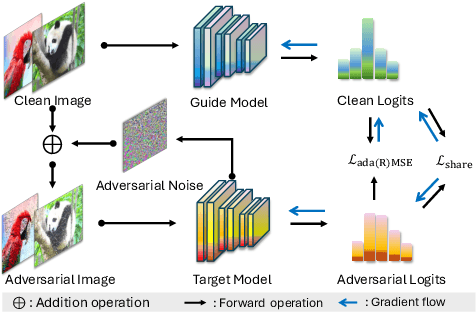
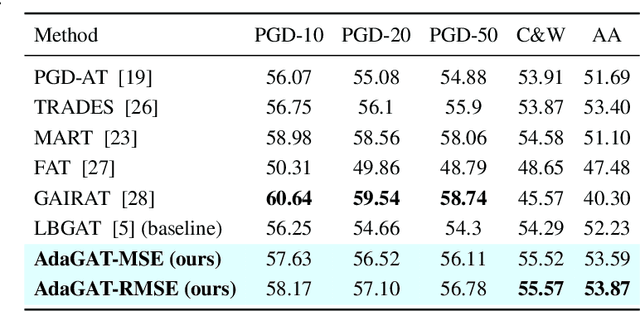
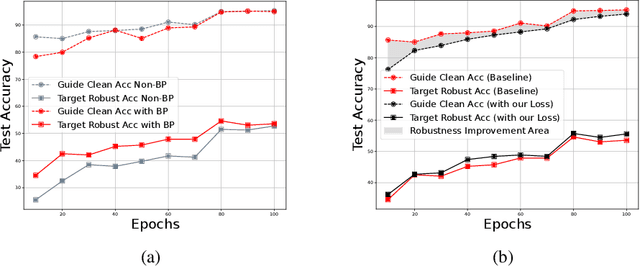
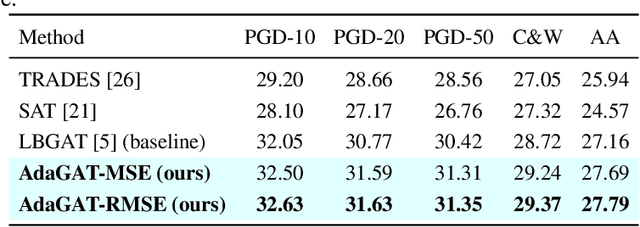
Abstract:Adversarial distillation (AD) is a knowledge distillation technique that facilitates the transfer of robustness from teacher deep neural network (DNN) models to lightweight target (student) DNN models, enabling the target models to perform better than only training the student model independently. Some previous works focus on using a small, learnable teacher (guide) model to improve the robustness of a student model. Since a learnable guide model starts learning from scratch, maintaining its optimal state for effective knowledge transfer during co-training is challenging. Therefore, we propose a novel Adaptive Guidance Adversarial Training (AdaGAT) method. Our method, AdaGAT, dynamically adjusts the training state of the guide model to install robustness to the target model. Specifically, we develop two separate loss functions as part of the AdaGAT method, allowing the guide model to participate more actively in backpropagation to achieve its optimal state. We evaluated our approach via extensive experiments on three datasets: CIFAR-10, CIFAR-100, and TinyImageNet, using the WideResNet-34-10 model as the target model. Our observations reveal that appropriately adjusting the guide model within a certain accuracy range enhances the target model's robustness across various adversarial attacks compared to a variety of baseline models.
Deep Learning-Assisted Detection of Sarcopenia in Cross-Sectional Computed Tomography Imaging
Aug 24, 2025Abstract:Sarcopenia is a progressive loss of muscle mass and function linked to poor surgical outcomes such as prolonged hospital stays, impaired mobility, and increased mortality. Although it can be assessed through cross-sectional imaging by measuring skeletal muscle area (SMA), the process is time-consuming and adds to clinical workloads, limiting timely detection and management; however, this process could become more efficient and scalable with the assistance of artificial intelligence applications. This paper presents high-quality three-dimensional cross-sectional computed tomography (CT) images of patients with sarcopenia collected at the Freeman Hospital, Newcastle upon Tyne Hospitals NHS Foundation Trust. Expert clinicians manually annotated the SMA at the third lumbar vertebra, generating precise segmentation masks. We develop deep-learning models to measure SMA in CT images and automate this task. Our methodology employed transfer learning and self-supervised learning approaches using labelled and unlabeled CT scan datasets. While we developed qualitative assessment models for detecting sarcopenia, we observed that the quantitative assessment of SMA is more precise and informative. This approach also mitigates the issue of class imbalance and limited data availability. Our model predicted the SMA, on average, with an error of +-3 percentage points against the manually measured SMA. The average dice similarity coefficient of the predicted masks was 93%. Our results, therefore, show a pathway to full automation of sarcopenia assessment and detection.
D2R: dual regularization loss with collaborative adversarial generation for model robustness
Jun 08, 2025Abstract:The robustness of Deep Neural Network models is crucial for defending models against adversarial attacks. Recent defense methods have employed collaborative learning frameworks to enhance model robustness. Two key limitations of existing methods are (i) insufficient guidance of the target model via loss functions and (ii) non-collaborative adversarial generation. We, therefore, propose a dual regularization loss (D2R Loss) method and a collaborative adversarial generation (CAG) strategy for adversarial training. D2R loss includes two optimization steps. The adversarial distribution and clean distribution optimizations enhance the target model's robustness by leveraging the strengths of different loss functions obtained via a suitable function space exploration to focus more precisely on the target model's distribution. CAG generates adversarial samples using a gradient-based collaboration between guidance and target models. We conducted extensive experiments on three benchmark databases, including CIFAR-10, CIFAR-100, Tiny ImageNet, and two popular target models, WideResNet34-10 and PreActResNet18. Our results show that D2R loss with CAG produces highly robust models.
UoR-NCL at SemEval-2025 Task 1: Using Generative LLMs and CLIP Models for Multilingual Multimodal Idiomaticity Representation
Feb 28, 2025



Abstract:SemEval-2025 Task 1 focuses on ranking images based on their alignment with a given nominal compound that may carry idiomatic meaning in both English and Brazilian Portuguese. To address this challenge, this work uses generative large language models (LLMs) and multilingual CLIP models to enhance idiomatic compound representations. LLMs generate idiomatic meanings for potentially idiomatic compounds, enriching their semantic interpretation. These meanings are then encoded using multilingual CLIP models, serving as representations for image ranking. Contrastive learning and data augmentation techniques are applied to fine-tune these embeddings for improved performance. Experimental results show that multimodal representations extracted through this method outperformed those based solely on the original nominal compounds. The fine-tuning approach shows promising outcomes but is less effective than using embeddings without fine-tuning. The source code used in this paper is available at https://github.com/tongwu17/SemEval-2025-Task1-UoR-NCL.
CRRG-CLIP: Automatic Generation of Chest Radiology Reports and Classification of Chest Radiographs
Dec 31, 2024



Abstract:The complexity of stacked imaging and the massive number of radiographs make writing radiology reports complex and inefficient. Even highly experienced radiologists struggle to maintain accuracy and consistency in interpreting radiographs under prolonged high-intensity work. To address these issues, this work proposes the CRRG-CLIP Model (Chest Radiology Report Generation and Radiograph Classification Model), an end-to-end model for automated report generation and radiograph classification. The model consists of two modules: the radiology report generation module and the radiograph classification module. The generation module uses Faster R-CNN to identify anatomical regions in radiographs, a binary classifier to select key regions, and GPT-2 to generate semantically coherent reports. The classification module uses the unsupervised Contrastive Language Image Pretraining (CLIP) model, addressing the challenges of high-cost labelled datasets and insufficient features. The results show that the generation module performs comparably to high-performance baseline models on BLEU, METEOR, and ROUGE-L metrics, and outperformed the GPT-4o model on BLEU-2, BLEU-3, BLEU-4, and ROUGE-L metrics. The classification module significantly surpasses the state-of-the-art model in AUC and Accuracy. This demonstrates that the proposed model achieves high accuracy, readability, and fluency in report generation, while multimodal contrastive training with unlabelled radiograph-report pairs enhances classification performance.
Dynamic Label Adversarial Training for Deep Learning Robustness Against Adversarial Attacks
Aug 23, 2024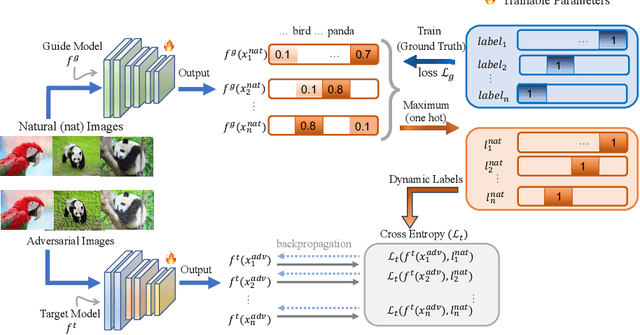
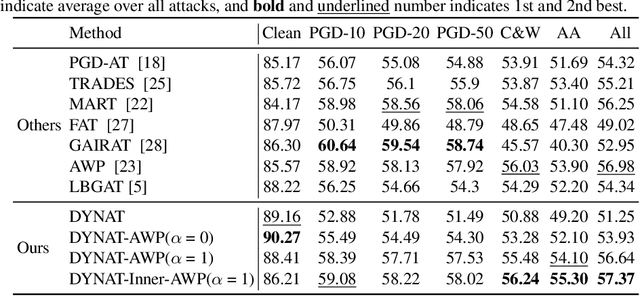
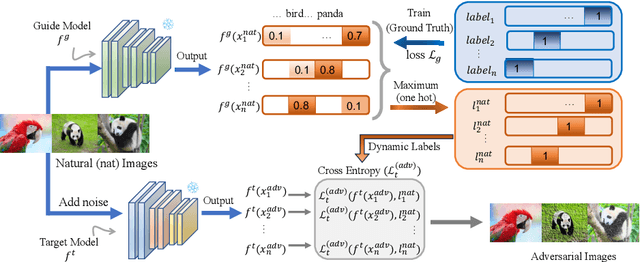

Abstract:Adversarial training is one of the most effective methods for enhancing model robustness. Recent approaches incorporate adversarial distillation in adversarial training architectures. However, we notice two scenarios of defense methods that limit their performance: (1) Previous methods primarily use static ground truth for adversarial training, but this often causes robust overfitting; (2) The loss functions are either Mean Squared Error or KL-divergence leading to a sub-optimal performance on clean accuracy. To solve those problems, we propose a dynamic label adversarial training (DYNAT) algorithm that enables the target model to gradually and dynamically gain robustness from the guide model's decisions. Additionally, we found that a budgeted dimension of inner optimization for the target model may contribute to the trade-off between clean accuracy and robust accuracy. Therefore, we propose a novel inner optimization method to be incorporated into the adversarial training. This will enable the target model to adaptively search for adversarial examples based on dynamic labels from the guiding model, contributing to the robustness of the target model. Extensive experiments validate the superior performance of our approach.
On Learnable Parameters of Optimal and Suboptimal Deep Learning Models
Aug 21, 2024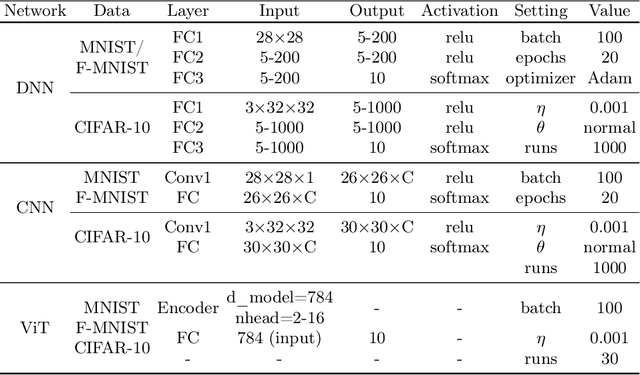
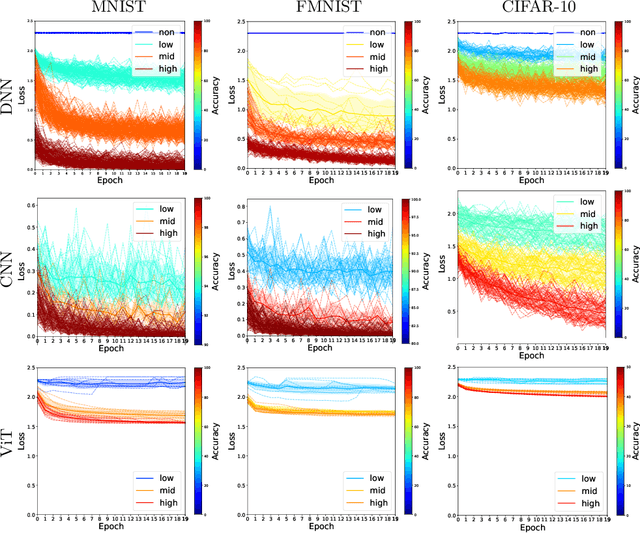
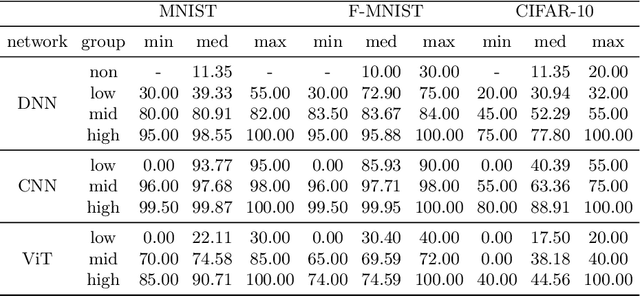
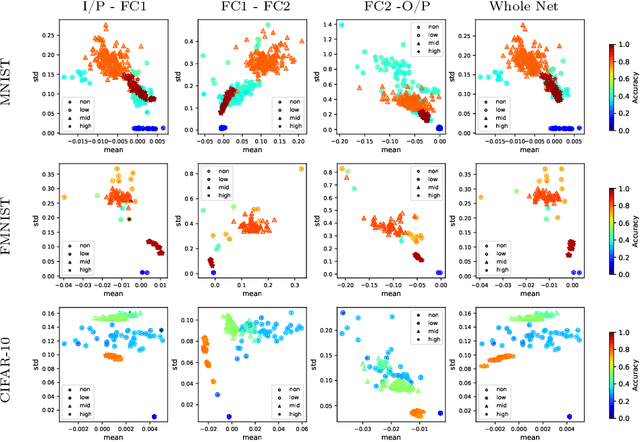
Abstract:We scrutinize the structural and operational aspects of deep learning models, particularly focusing on the nuances of learnable parameters (weight) statistics, distribution, node interaction, and visualization. By establishing correlations between variance in weight patterns and overall network performance, we investigate the varying (optimal and suboptimal) performances of various deep-learning models. Our empirical analysis extends across widely recognized datasets such as MNIST, Fashion-MNIST, and CIFAR-10, and various deep learning models such as deep neural networks (DNNs), convolutional neural networks (CNNs), and vision transformer (ViT), enabling us to pinpoint characteristics of learnable parameters that correlate with successful networks. Through extensive experiments on the diverse architectures of deep learning models, we shed light on the critical factors that influence the functionality and efficiency of DNNs. Our findings reveal that successful networks, irrespective of datasets or models, are invariably similar to other successful networks in their converged weights statistics and distribution, while poor-performing networks vary in their weights. In addition, our research shows that the learnable parameters of widely varied deep learning models such as DNN, CNN, and ViT exhibit similar learning characteristics.
Review of Explainable Graph-Based Recommender Systems
Jul 31, 2024Abstract:Explainability of recommender systems has become essential to ensure users' trust and satisfaction. Various types of explainable recommender systems have been proposed including explainable graph-based recommender systems. This review paper discusses state-of-the-art approaches of these systems and categorizes them based on three aspects: learning methods, explaining methods, and explanation types. It also explores the commonly used datasets, explainability evaluation methods, and future directions of this research area. Compared with the existing review papers, this paper focuses on explainability based on graphs and covers the topics required for developing novel explainable graph-based recommender systems.
Does Knowledge Graph Really Matter for Recommender Systems?
Apr 04, 2024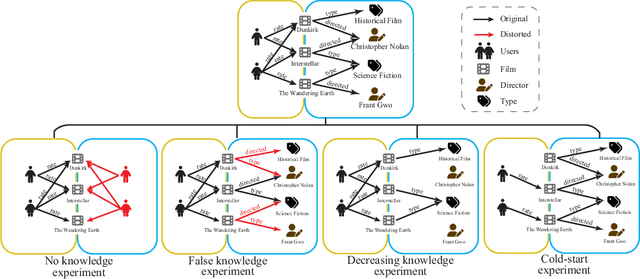

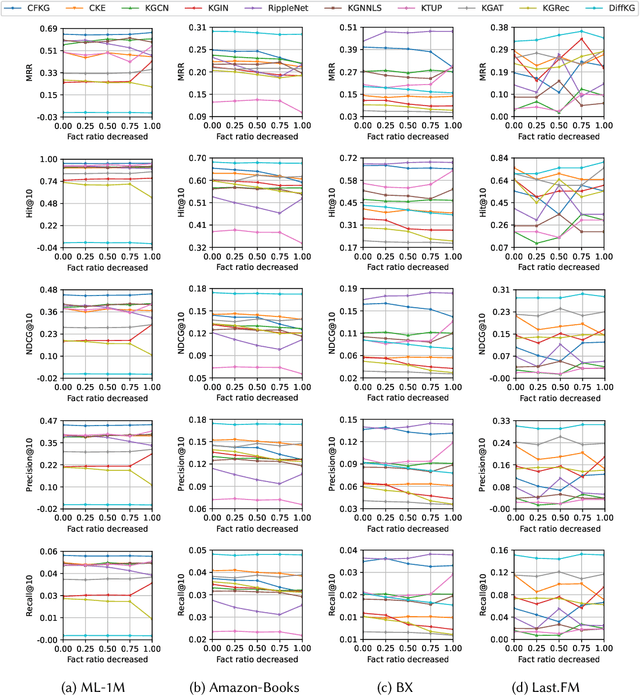
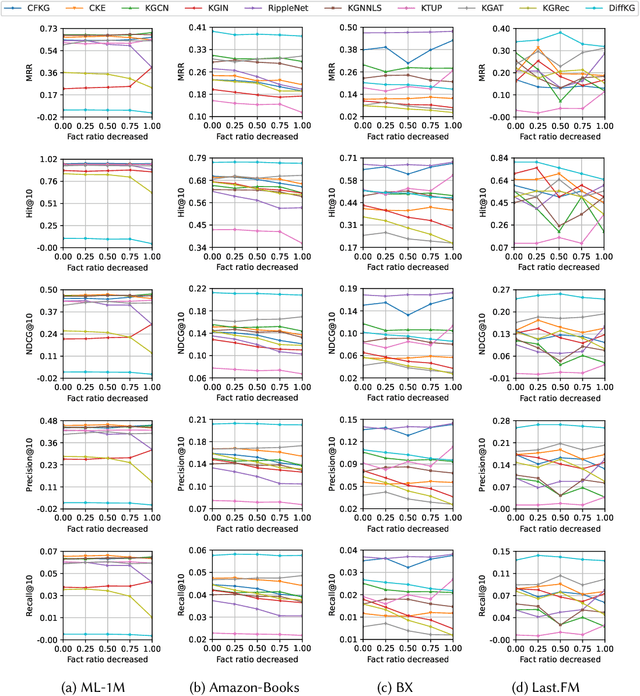
Abstract:Recommender systems (RSs) are designed to provide personalized recommendations to users. Recently, knowledge graphs (KGs) have been widely introduced in RSs to improve recommendation accuracy. In this study, however, we demonstrate that RSs do not necessarily perform worse even if the KG is downgraded to the user-item interaction graph only (or removed). We propose an evaluation framework KG4RecEval to systematically evaluate how much a KG contributes to the recommendation accuracy of a KG-based RS, using our defined metric KGER (KG utilization efficiency in recommendation). We consider the scenarios where knowledge in a KG gets completely removed, randomly distorted and decreased, and also where recommendations are for cold-start users. Our extensive experiments on four commonly used datasets and a number of state-of-the-art KG-based RSs reveal that: to remove, randomly distort or decrease knowledge does not necessarily decrease recommendation accuracy, even for cold-start users. These findings inspire us to rethink how to better utilize knowledge from existing KGs, whereby we discuss and provide insights into what characteristics of datasets and KG-based RSs may help improve KG utilization efficiency.
 Add to Chrome
Add to Chrome Add to Firefox
Add to Firefox Add to Edge
Add to Edge